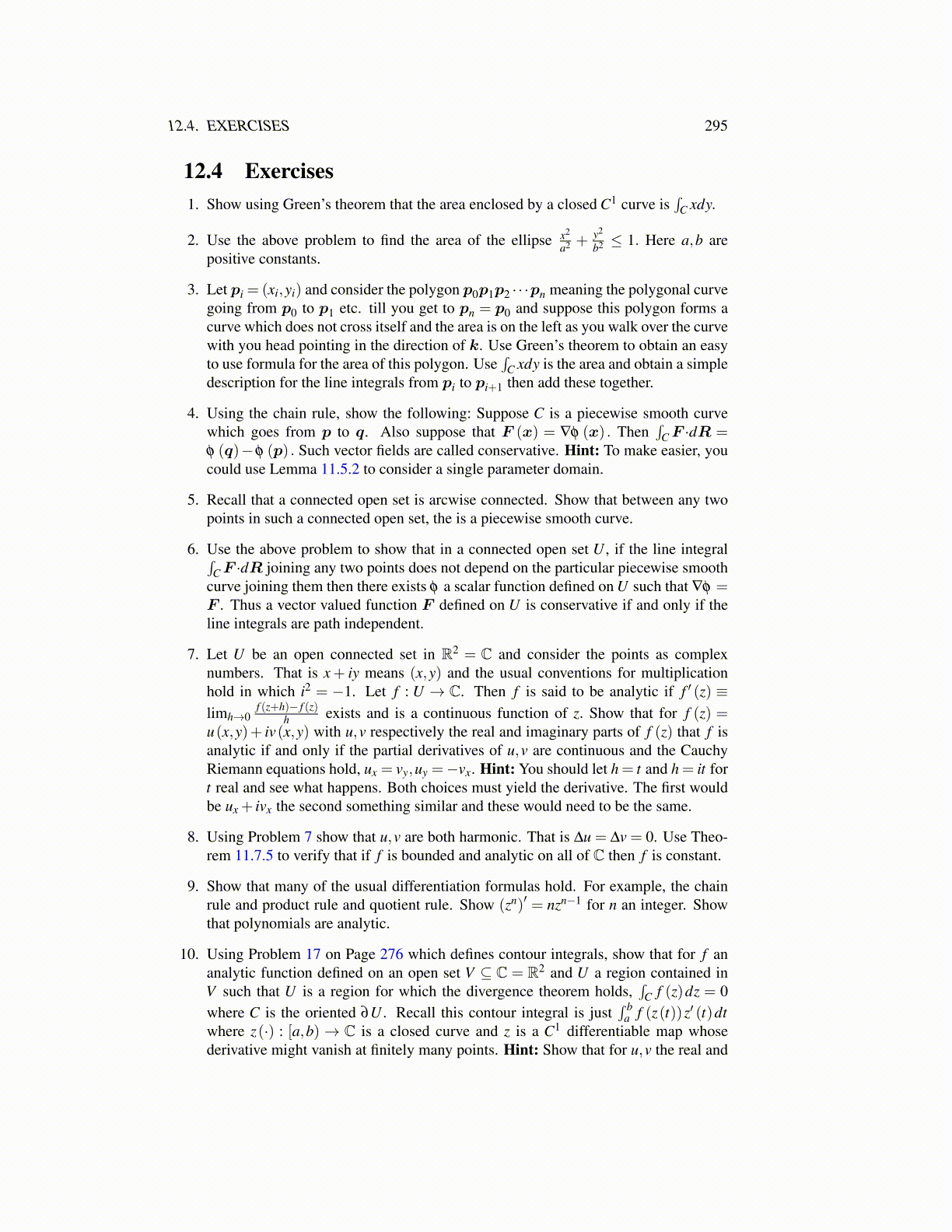
12.4. EXERCISES 295
12.4 Exercises1. Show using Green’s theorem that the area enclosed by a closed C1 curve is
∫C xdy.
2. Use the above problem to find the area of the ellipse x2
a2 +y2
b2 ≤ 1. Here a,b arepositive constants.
3. Let pi = (xi,yi) and consider the polygon p0p1p2 · · ·pn meaning the polygonal curvegoing from p0 to p1 etc. till you get to pn = p0 and suppose this polygon forms acurve which does not cross itself and the area is on the left as you walk over the curvewith you head pointing in the direction of k. Use Green’s theorem to obtain an easyto use formula for the area of this polygon. Use
∫C xdy is the area and obtain a simple
description for the line integrals from pi to pi+1 then add these together.
4. Using the chain rule, show the following: Suppose C is a piecewise smooth curvewhich goes from p to q. Also suppose that F (x) = ∇φ (x) . Then
∫C F ·dR =
φ (q)−φ (p) . Such vector fields are called conservative. Hint: To make easier, youcould use Lemma 11.5.2 to consider a single parameter domain.
5. Recall that a connected open set is arcwise connected. Show that between any twopoints in such a connected open set, the is a piecewise smooth curve.
6. Use the above problem to show that in a connected open set U , if the line integral∫C F ·dR joining any two points does not depend on the particular piecewise smooth
curve joining them then there exists φ a scalar function defined on U such that ∇φ =F . Thus a vector valued function F defined on U is conservative if and only if theline integrals are path independent.
7. Let U be an open connected set in R2 = C and consider the points as complexnumbers. That is x+ iy means (x,y) and the usual conventions for multiplicationhold in which i2 = −1. Let f : U → C. Then f is said to be analytic if f ′ (z) ≡limh→0
f (z+h)− f (z)h exists and is a continuous function of z. Show that for f (z) =
u(x,y)+ iv(x,y) with u,v respectively the real and imaginary parts of f (z) that f isanalytic if and only if the partial derivatives of u,v are continuous and the CauchyRiemann equations hold, ux = vy,uy =−vx. Hint: You should let h = t and h = it fort real and see what happens. Both choices must yield the derivative. The first wouldbe ux + ivx the second something similar and these would need to be the same.
8. Using Problem 7 show that u,v are both harmonic. That is ∆u = ∆v = 0. Use Theo-rem 11.7.5 to verify that if f is bounded and analytic on all of C then f is constant.
9. Show that many of the usual differentiation formulas hold. For example, the chainrule and product rule and quotient rule. Show (zn)′ = nzn−1 for n an integer. Showthat polynomials are analytic.
10. Using Problem 17 on Page 276 which defines contour integrals, show that for f ananalytic function defined on an open set V ⊆ C = R2 and U a region contained inV such that U is a region for which the divergence theorem holds,
∫C f (z)dz = 0
where C is the oriented ∂U . Recall this contour integral is just∫ b
a f (z(t))z′ (t)dtwhere z(·) : [a,b)→ C is a closed curve and z is a C1 differentiable map whosederivative might vanish at finitely many points. Hint: Show that for u,v the real and